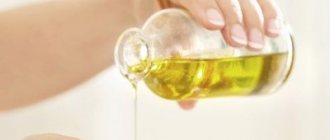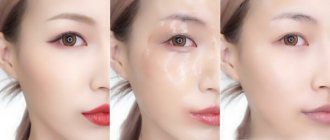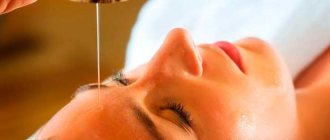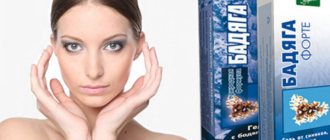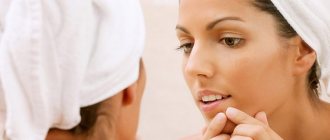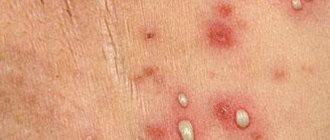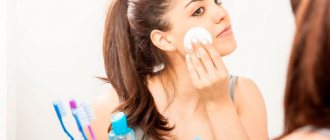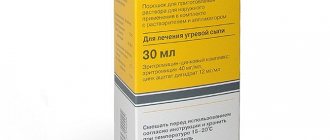What is post-acne
Acne can appear on the face and neck, in the interscapular area, on the back and in the upper chest. Acne or acne is the formation of inflammatory elements on the skin - compacted reddened tubercles (papules) and blackheads, purulent white heads with redness around them. If elements are injured, squeezed out or heal poorly, post-inflammatory, scarring, and pigmentary changes form on the skin - this is post-acne.
This is what post-acne looks like
Is it possible to do peeling if rashes appear?
Abscesses* on the face are a sign of an inflammatory process and one of the contraindications to many cosmetic procedures, including peelings.
Abrasive particles and aggressive acids can injure the skin, aggravate the inflammatory process, lead to rupture of pustules and penetration of pus into the dermal tissue, which will worsen the existing pathology.
In this case, it will be even more difficult to cope with the rash. Therefore, peelings cannot be done for pustules* on the face.
Other contraindications to exfoliation are:
- pregnancy and lactation;
- exacerbation of herpes;
- ARI, viral/infectious lesion of the body;
- increased body temperature for any reason;
- the presence of burns or any violations of the integrity of the skin on the treated area;
- high solar activity – period from March to October.
The presence of any contraindication is a reason to refuse the planned procedure.
Reasons for the appearance and areas of localization of post-acne
The skin is the largest organ in the human body, and it has a complex structure. In addition to the epithelial cells that form the continuous skin, there are also hair follicles, sweat and sebaceous glands. It is the glands that secrete sebum and form a protective hydrolipidic mantle on the surface of the epithelium that suffer during the development of acne.
To begin with, it is important to understand why acne occurs. When the sebaceous glands malfunction, the epithelium in the area of the ducts thickens, the lumen of the gland narrows and sebum cannot be regularly and fully released through the pores to the surface. Then the fatty secretion is retained inside the gland duct itself, which provokes inflammation with the participation of microbes that are constantly present on the surface of the skin, making up its microflora.
The process of acne formation goes through certain stages:
Initially, comedones are formed - an increase in the size of the sebaceous gland. Nodules form in the skin with an irritated opening of the sebaceous gland. As the process develops, black dots form in the center, and disturbances in the outflow of sebum, microbial activity, and the work of leukocytes during inflammation lead to the formation of purulent heads (pustules).
By themselves, these elements can leave behind scars and uneven skin, and if they are further injured, if you squeeze out blackheads or purulent heads, the inflammation only intensifies, and the purulent contents can spread to neighboring areas of the skin.
To prevent inflammation from spreading, to prevent damage to more and more areas of tissue, and to prevent pus from penetrating into neighboring areas, inflammatory changes form around the damage to the sebaceous gland.
Swelling occurs in the area of the pimple, collagen production is stimulated, scar changes are formed: connective tissue elements are formed, new capillaries grow, which gives redness, the work of pigment cells is stimulated - pigment spots are formed - persistent and with uneven edges.
Especially often, problems arise on the face, mainly in the forehead, on the nose and cheeks, on the chest, they also appear in the décolleté or on the back.
Redness disappears over time, pigmentation becomes less bright, scars can atrophy, forming dimples, or, conversely, become convex and rough.
Tips from cosmetologists
Acne is a problem that can be quickly overcome with peelings. However, it is important to take into account the opinion of professionals in order to significantly improve the result and reduce the period of skin recovery after the procedure.
Some doctors argue that to consolidate the result, it is necessary to cleanse at least several times. Thus, therapy consisting of several procedures will give a greater effect than a single one. At the same time, it is important to observe time for skin restoration before each peeling - on average 10-15 days (depending on the type).
The list of useful tips from professionals in the field of cosmetology includes the following:
- To get rid of acne on your skin for a long time, you need to do at least one cleansing a year. It is better to take a break in the summer or spring, when there is an increased level of ultraviolet radiation.
- Pay special attention to post-peeling care. Use protective creams in the sun, and add cosmetics based on thermal water, hyaluronic acid or vitamins to the list of skin care products. This approach will help on the path to instant and comfortable recovery.
- If possible, exclude oil-based items from your cosmetic bag. Fat creams will not be able to stop peeling, as this is a natural process after any peeling.
In addition, cosmetologists categorically do not recommend visiting a bathhouse, solarium, swimming pool or sauna for the first time after peeling. For rapid regeneration, it is recommended to use moisturizing creams.
Types and stages of post-acne
Among the main signs of post-acne, hyperpigmentation is identified - these are areas of normally colored and darker skin, alternating with each other and forming an uneven tone.
In addition, the typical presence of stagnant red spots, enlarged skin pores, often filled with sebum, as well as pathological scars. In the area of blockage of the sebaceous glands, atheromas (sebaceous gland cysts filled with fatty secretions) or milia (whiteheads) are formed.
The main sign of post-acne is old cicatricial changes, scars after healed purulent acne. They can take three forms:
- depressed areas of skin, dimples (or atrophic scars);
- convex, lumpy areas, often with areas of erythema (hypertrophic);
- areas of dyschromia (the surface of the skin is spotty, with areas of increased pigmentation).
Sometimes the formation of keloid scars is mistakenly added to the classification. This is the wrong approach. People with a hereditary predisposition to the formation of rough and poorly healing scars that disfigure the appearance do not often suffer from acne, and therefore post-acne phenomena are rare for them.
The most common type of post-acne is the appearance of atrophic scars. According to the Jacob CI classification, they can take the form of rounded, chipped and square elements. This division helps doctors plan treatment and predict its results.
Round scars are the shallowest, and the prognosis for them is the most favorable. The square ones are somewhat deeper, but are also eliminated quite well. The biggest problem is the chipped forms of post-acne, they look like the Latin letter “V”, their bottom is located deep in the dermis.
Types of skin damage from acne
Benefits of the procedure
This procedure has many positive aspects. The main ones are:
- ease of use;
- cheapness of the product itself;
- safety;
- gentle and gentle effect on the skin;
- painlessness;
- lack of recovery period and long preparation;
- quick positive effect;
- no age restrictions;
- universality of the procedure (suitable for any skin type).
This procedure is especially suitable for those who do not have the financial means or means to visit an aesthetic clinic frequently. This is a simple and affordable procedure that gives 100% effect.
Unlike other cleansing products (scrubs), rollers do not contain aggressive abrasive components that injure dry, irritable and problematic skin. The product is atraumatic because it acts softly and delicately.
A gentle facial massage during peeling can:
- improve blood microcirculation;
- have a draining effect;
- activate cellular metabolism;
- speed up regeneration processes;
- eliminate stagnant processes.
Ways to get rid of post-acne
The intensity of post-acne is directly related to the severity of acne. Therefore, it is important to work not only to eliminate the consequences, but also to prevent the appearance of new elements on the skin. It is necessary to fight acne itself, eliminating its main causes. If pimples appear again and again, the prognosis for post-acne treatment is questionable; inflammation will give rise to new scars. Therefore, work with an experienced dermatologist-cosmetologist is required.
Most of the work on restoring, smoothing the skin and eliminating scars is carried out by a cosmetologist, but certain activities can also be performed at home. Moreover, only an integrated approach will give the most maximum results.
What can you do at home?
At home, you need to help the skin recover; it needs building elements and proper nutrition. To regenerate the skin and form its structure, it is necessary to supply vitamins and minerals, protein as a source of amino acids for the construction of collagen fibers and the synthesis of hyaluronic acid, which moisturizes and gives the skin tone and smoothness.
In addition, omega acids are important, which are involved in cell renewal and form cell membranes. It is important to adjust your diet, eliminate as much processed foods as possible, food chemicals (dyes, preservatives, E-additives) and give up bad habits.
To prevent new acne and improve tone, nourish the skin, heal inflammation and small scars, pharmaceutical products will help. You can use 1% salicylic alcohol or boric acid and wipe the skin with it twice a day. Levomekol ointment works quite well in treating acne, suppressing inflammation and eliminating scars. Many people use bodyaga powder, which is diluted in water to a paste and applied to the affected area. But before using all these remedies, it is important to first consult with your doctor to prevent side effects and complications.
Skin care is complemented by serums, care creams (day and night) selected by a cosmetologist, as well as homemade peelings with fruit acids. They delicately exfoliate the skin, remove dead cells, and cleanse its surface.
Folk remedies are often used, for example, infusions of St. John's wort and chamomile, which have an anti-inflammatory, soothing, cleansing effect. You can freeze them and wipe the skin with the resulting ice cubes, further increasing blood circulation and capillary tone.
You can also use masks with blue clay. The recipe for making a mask is very simple: three tablespoons of powder are diluted in water to a paste, applied to the problem area for 20 minutes and then thoroughly washed off with water.
What treatment methods are used in a cosmetology clinic?
Although homemade recipes help in the fight against post-acne, you should not think that only through them you can eliminate all problems. Home methods act on the very top layers of the skin and reduce only minor defects.
Modern cosmetic procedures will help get rid of deep scars, pigmentation and unevenness. But don't expect instant results.
Treatment methods are selected individually and comprehensively. The more severe the initial problem and the wider the affected area, the longer the treatment will be.
To achieve maximum smoothness of the skin and an even complexion or eliminate blemishes on the body, you need a whole series of procedures, supplemented by home care and carefully selected cosmetics. On average, the first noticeable results will be visible after 1-2 months with regular implementation of all necessary treatment measures.
If there is unevenness, decreased skin tone, pigmented or stagnant spots, peelings . There are a lot of treatment options: these can be mechanical peels (compositions with herbs, small dense particles) and chemical peels (with retinol, glycolic, resorcinol or other compounds).
With mechanical peeling, the effect of cleansing and exfoliation is achieved due to the mechanical scraping of the particles included in the composition of the upper layer of skin with outdated epithelial cells.
With chemical peeling, a similar effect is achieved through chemical cauterization of the upper layer of the epidermis, which leads to its subsequent rejection with peeling.
The cosmetologist selects peelings to suit your needs and strictly follows all the rules for their implementation in order to achieve maximum effect and avoid side effects. On average, the first results are visible after 5-6 procedures.
A more effective analogue of peeling is laser skin resurfacing . The doctor performs the procedure with a special laser unit with a strictly specified wavelength in order to influence the skin at the required depth without damaging neighboring tissues. The laser beam cauterizes the skin, the treated areas are actively exfoliated, which allows stimulating the regeneration of new tissues, more even and smooth.
Check out our patient's review of laser facial resurfacing:
Photothermolysis is a more advanced method of laser skin treatment. The rays do not act as a continuous field, but as individual points - creating a mesh on the treated area. This is a fairly effective, but less traumatic effect; the rehabilitation period after such procedures is reduced.
dermabrasion is used to combat skin imperfections . This is the use of aluminum oxide powder under pressure or a special rotating abrasive disc for mechanical grinding of the skin, removing the upper layers of the epidermis from it.
Filler injections can help eliminate atrophic scars and dimples and smooth out the skin . They are inserted under the defect area, create additional volume, and lift depressed skin. The effect lasts up to 6-10 months (depending on the drug), then the injections are repeated.
Mesotherapy with drugs that stimulate collagen synthesis and epidermal renewal gives good results A series of microinjections are made into the surface layers of the skin with the introduction of hyaluronic acid, antioxidants, and vitamin components. The cosmetologist selects a specific drug depending on the tasks and the severity of skin defects.
Another method is ozone therapy . This is a technique of introducing a special oxygen mixture into a problem area through a series of microinjections. The composition helps saturate tissues with oxygen, stimulates blood circulation or lymph drainage, and epithelial regeneration.
If no other methods have produced a significant effect, surgical removal of scars can be used. The affected scar tissue is excised within the boundaries of healthy skin. The rehabilitation process is long, and the intervention itself can also leave scars in the future.
Post-acne treatment at Dr. Gruzdev’s clinic:
Chemical peeling The clinic offers gentle superficial peels: almond and glycolic.
More details
Laser resurfacing Impact of a laser beam on problem areas of the surface layer of the dermis.
More details
Biorevitalization A non-surgical technique for facial rejuvenation using preparations based on hyaluronic acid.
More details
Mesotherapy An injection technique for introducing “cocktails” into the skin based on vitamins, microelements, and amino acids.
More details
The best peeling rolls for the face: TOP 10 products for home use
There is such a large assortment of cosmetics on the modern market that it can be very difficult to make a choice just by going to the store. Therefore, we suggest that you familiarize yourself with the rating of the best peeling rolls for the face, based on numerous positive user reviews.
Peeling roller Super Aqua from MISSHA, made in Korea
The first place in the rating of facial peeling rolls is occupied by a product enriched with oxygen and containing extracts of flowers, seeds, as well as acids with enzymes of exotic fruits. Deeply cleanses, perfectly moisturizes and gives the skin an inner glow. Many users note the pleasant aroma and economical packaging (although some talk about the not very convenient dispenser and weak exfoliating effect).
Volume – 100 ml, price – about 1500 rubles.
Korean apple roll MIZON
The malic and hyaluronic acids in the composition gently cleanse even very thin and sensitive skin. MIZON peeling roller perfectly nourishes the dermis thanks to fruit enzymes and sugar cane extract. This is a fairly thick, easy-to-apply gel that does not spread during use. The disadvantage of fruit peeling roller for the face is its low effectiveness in the fight against blackheads.
Volume – 120 ml, price – about 900 rubles.
Italian roll LIMONI
Despite the fact that the active component of the composition is malic acid, the product is memorable for its lemon aroma. During massaging, the gel structure turns into light foam. After systematic use of the Italian Limoni roller, traces of acne disappear and the oval of the face is tightened.
Tube 150 ml, cost about 800 rubles.
Original Korean facial peeling roll TONY MOLY
This product is known for its original shape and creamy structure. The product nourishes and moisturizes the skin, evens out the complexion, prevents acne and tightens pores. Some users say that this Korean facial peeling roller is difficult to wash off.
Capacity – 80 ml, average price – 850 rubles.
Korean peeling with egg enzymes HOLIKA HOLIKA
This Korean brand is known for its hypoallergenic rolls, which are sprayed using a dispenser onto steamed, damp skin. Cleansing facial peeling with egg white extract perfectly fights blackheads, refreshes and exfoliates dead skin areas. Users note the ability to cleanse the skin “squeaky clean.”
Volume – 140 ml, price – from 700 rubles.
THE SAEM facial peeling roller (made in Korea)
The uniqueness of this tool lies in the permissible frequency of its use. According to reviews, even four times use within one week has a beneficial effect on the condition of the skin. Stem cells and pine bark extract in the composition have a rejuvenating, brightening and toning effect.
Volume – 40 and 160 ml, price – 450 and 1500 rubles, respectively.
Russian facial peeling LIBREDERM with chamomile
Not a very effective product that can be used for any, even the most sensitive skin. LIBREDERM face peeling roll does not contain artificial colors or flavors, has a cloudy color and a barely noticeable aroma. The product exfoliates dead cells well, leaving the face fresh and moisturized.
The cost of 75 ml is only 300 rubles.
Japanese matting roller SHISEIDO
Users have a mixed opinion about the composition, rich in vitamins and antioxidants: the first admire the good exfoliating and matting effect, the second talk about overly sticky particles that injure the delicate skin of the face.
Tube 100 ml, price – about 600 rubles.
Belarusian milk facial peeling BELITA
Inexpensive mesopeeling based on lactic acid is characterized by a granular texture. When massaged, the particles completely dissolve without causing any harm to the skin. This face roll polishes and mattifies well. Many people note a slight tingling sensation during use, which is accompanied by improved blood flow.
A 100 ml container costs approximately 170 rubles.
Facial peeling roll PROPELLER with salicylic acid
This is the most budget option of all presented ( 150 rubles per 100 ml ). It is characterized by not very good rollability and a runny texture, although many note the positive effect of peeling on problematic facial skin.
Read material on the topic: Retinoic yellow peeling done by Hollywood stars
How to quickly lighten or disguise post-acne
It is important to understand that the fight against post-acne is a long-term process; it is necessary to gradually even out the skin, stimulate the regeneration process, normalize blood circulation and metabolic processes in the epidermis and dermis.
Primers, foundations and decorative cosmetics can hide skin defects, but they do not improve, but only worsen the situation, clog pores, prevent the skin from breathing and create a breeding ground for bacteria.
It is impossible to hide acne marks, eliminate scars and even out your complexion by eliminating pigmentation in one day or even a week.
Home peelings will only improve the situation a little, but for deeper effects (chemical peels, laser, mesotherapy) time is needed for rehabilitation (exfoliation, elimination of redness and skin irritation).
To eliminate pigmentation and whiten the skin, a series of procedures and properly selected cosmetic products for subsequent care are required. There are simply no miraculous and safe products that, when applied overnight, will eliminate all unevenness and imperfections.
Possible side effects of facial peeling roller
Complications after using a facial peeling roll are quite rare.
User frustrations in most cases are associated with:
- lack of immediate results;
- the occurrence of allergic reactions;
- the appearance of age spots.
It is worth noting that redness and peeling of the skin are most often found after using home remedies containing calcium chloride.
How to prevent acne and post-acne
To prevent acne and the development of post-acne, you must follow the rules of face and body care. It is important to use cleansing and skin care products selected for your age and skin type, and use them only for their intended purpose and according to the instructions.
Do not squeeze blackheads or white pimples.
To speed up their healing, you can use special creams, serums or other targeted products. If acne does not go away or its number increases, a visit to a dermatologist is necessary.
To protect your skin from inflammation, try not to touch your face or rub it with your hands during the day; if you talk on the phone a lot, treat your gadget, as there are always a lot of bacteria on it that get on the skin.
Change your towels more often or ditch them in favor of disposable paper towels. Be sure to wash your face twice a day and take a shower. For washing, you need to choose mild cleansers. If you are prone to acne, you need a soft, delicate and well-cleansing cosmetic product. Regular soap or shower gel may be too harsh.
How to make a facial peeling roll at home
Now let's talk about how to use the peeling roller for the face:
- Before applying the product, the skin must first be washed well and cleaned of decorative cosmetics. In addition, you should prepare a moisturizer in advance. Since all rolling peels have a chemical composition, after using them you need to immediately saturate the skin with a moisturizer.
- Apply an even thin layer of the drug to a dry and cleansed face.
- Then massage the skin with gentle movements for 3-5 minutes.
- Wash off the composition and distribute the moisturizer over the surface of the face.
It is important to remember that frequency is important for any cosmetic procedure. With irregular use, you are unlikely to quickly see positive changes, and too frequent use, on the contrary, can cause peeling and redness. So how often should you perform procedures with a cleansing composition?
It all depends on your skin type:
- for normal skin – once or twice every seven days;
- for dry skin – once a week;
- for fatty women – three times every seven days.
Another important aspect is the duration of use. In order for positive changes to become noticeable, it will take several months of systematic use of the peeling ray. If you doubt the effectiveness of home treatments, you can always contact a professional in a beauty salon.
Read material on the topic: Gas-liquid skin peeling - beauty without pain and injections
What you will need to complete the procedure
Most of the tools are present in every girl’s home; other products can be purchased in the Alpika online store. You will need:
- Soft towel.
- Skin prep toner.
- Compound.
- Product for restoring pH balance.
- Cream for moisturizing and protecting against UV rays.
- Petrolatum.
- Brush or cotton swabs for applying the mixture.
You can prepare your own chemical facial peel recipe at home, but I strongly advise you to purchase a ready-made product. Since it contains the optimal concentration of components for a certain skin type. If you prepare it yourself, you may not distribute the ingredients correctly and cause serious harm to your skin.
After purchasing all the necessary tools, you can proceed directly to the cleansing procedure.
Step-by-step technology
- Wash your hands with soap.
- Remove makeup and cleanse your face with your usual product (tonic, foam, gel, etc.).
- Wash your face with water and dry your face with a towel.
- Apply Vaseline to the eye area, lips and eyebrows. This will help protect delicate areas from the effects of the drug.
- Read the recommendations for using the peeling product and strictly follow the application instructions.
- Using a brush or cotton swab, apply the composition first to the nose and chin, then to the forehead and cheeks. Make sure that the mixture is evenly distributed.
- Leave the product on the skin for the time indicated in the instructions. For the initial procedure, a minimum period of time is sufficient; depending on the frequency of use, you can increase the amount of time.
- Monitor your skin's reaction; if you feel any discomfort, remove the product immediately.
- After time has passed, rinse off the product with cool water or a special tonic that neutralizes the effects of acids.
- Treat your face with a product to restore pH balance.
- After the product is completely absorbed, apply a moisturizer.
